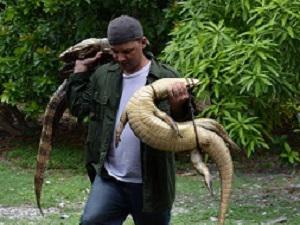Yoamel Milián-García
Other projects
16 Apr 2012
Genetic Characterization of the Critically Endangered Cuban Crocodile (Crocodylus rhombifer) and its Congener C Acutus in Cuba: A Conservationist Outlook I
31 Mar 2016
Conservation Genetics and Molecular Systematics of Cuban Crocodylus (Crocodylia: Crocodylidae)
To evaluate the phylogenetic relationships of the Cuban crocodiles, and to generate necessary information to develop communication actions for the Conservation of the Cuban crocodiles. This study would allow, for the first time, the evaluation of the intraspecific differentiation of the Cuban C.
acutus.

Mating.
In Cuba can be found two of the four species of the genus Crocodylus that belong to the New World: Crocodylus rhombifer and C. acutus; the first one being endemic and in real risk of extinction (stated as Critically Endangered by the IUCN).

An understanding of the systematics, natural history, and population structure of species is essential for establishing effective conservation and management plans. Conservation biology is now expanding to include many sub-disciplines and approaches, allowing us to investigate how large-scale events influence species richness, ecological adaptation, and extinction in different regions. Studies of wildlife population now often rely on genetics to establish priorities for conservation. Preliminary genetic examination of the Cuban crocodiles has indicated that C. acutus population in Cuba could represent an undescribed species with minimal morphological divergence, but substantial genetic divergence, from Central American populations. Nevertheless, no taxonomic changes have been proposed yet, due to the necessity of more genetic studies to more thoroughly understand the New World Crocodylus systematic relationships.
In addition, primary molecular data showed that C. acutus is paraphyletic with respect to C. rhombifer, revealing 1% sequence divergence between species within Cuba vs. 8% divergence between Cuban forms and mainland C. acutus. Generating new molecular information will be critical for determining the status species specific of the Cuban Crocodylus species. Finally, genetic results generated in the previous project for the American crocodile that inhabits in Cuba revealed an unknown intraspecific differentiation not studied before.
The present proposal has the following general goals: to evaluate the phylogenetic relationships of the Cuban crocodiles, and to generate necessary information to develop communication actions for the Conservation of the Cuban crocodiles. This study would allow, for the first time, the evaluation of the intraspecific differentiation of the Cuban C. acutus.